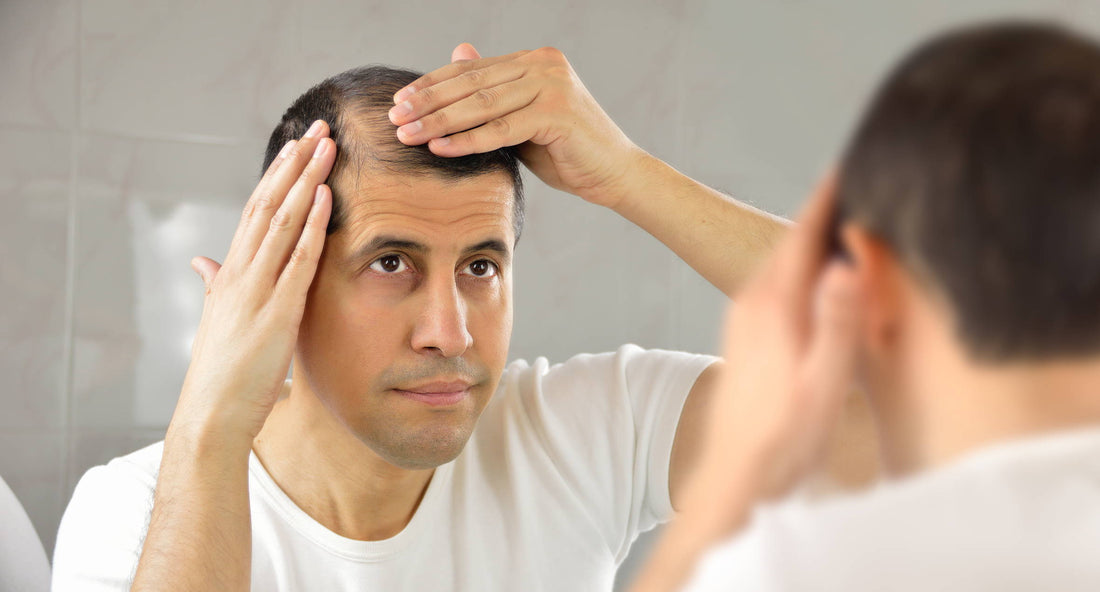Knowing the different terms used to describe hair loss is crucial if you are new to the hair loss world or are trying to navigate various treatment options. The region where hair loss occurs is one of the most important factors in determining what type of treatment you need–especially in a condition like androgenic alopecia, the most common cause of hair loss in men. But, several different terms are used to describe various parts of the head and scalp in relation to hair growth. Below, we share the different parts of the head and scalp for hair loss.
Different Parts of the Head and Scalp
The Frontal Region
The frontal region is where the hairline lies along your forehead. This area is the most obvious and is one of the most common places where hair loss occurs. If you have frontal hair loss, you will find that it can show up in a few different shapes or patterns. Men, in particular, are prone to having a ‘V’ or ‘M’ shape show up on their hairline, where hair still grows in the center of the forehead on the hairline but starts to recede on either side. Another form of hair loss that can occur is when the whole hairline recedes.
Once you experience hair loss in this region, you may be particularly motivated to get your hair to grow back, as it is the part of your scalp that you see the most and present to the world.
The Crown
The crown of the head is pretty straightforward: imagine you have a crown on top of your head, where the center of the crown is where your, well, crown is located. It is essentially the top of your head and towards the back. You have likely seen men with this type of hair loss. Often, they have hair surrounding the crown of their head, but a bald patch may emerge in this area.
Unfortunately, hair loss on the crown is tough to treat and can be tough to identify early on since you don’t see it regularly. Therefore, the earlier you notice this area and become proactive in treating hair loss, the better.
The Vertex Transition Point
This region is the most classic area we think of when it comes to male balding. Located at the top of the head, this region is the point where the crown’s vertical plane and the mid-scalp horizontal plane meet.
Treat Hair Growth on Your Entire Scalp Now
The Mid-Scalp Region
This region is located between the frontal region and the crown. It generally starts about an inch above the temple and wraps around to the other side of the head. Most men will not experience hair loss in this area until other areas have shown hair loss. However, it is important to keep the hair in this region healthy and robust so that you do not eventually see thinning here as well.
The Parietal Ridge
This region is the widest part of the head located on either side of the head. The parietal ridge is above the ears and is best identified by using a comb. When you lay a comb flat against your head above your ears and see the curve of your head move away from the scalp, you know you are in the parietal area. Most men will not have hair loss here with androgenic alopecia but will eventually experience hair thinning if they have not taken proactive steps to treat hair loss here.
The Nape
As the last major region we need to explore, the nape is essentially the posterior hairline. It starts where your frontal hairline ends and extends on either side to the back of your neck. This region is often unaffected by androgenic alopecia but is usually affected by autoimmune conditions like alopecia areata and frontal fibrosing alopecia.
Stimulate Scalp to Promote Healthy Hair Now
A Look at the Structure of Hair
Now that you know the primary regions of the head for treating hair loss, it helps to understand the basic structure of the hair. After all, when you read about different hair loss treatment methods, you will need to know how certain ingredients help to promote hair growth and suppress losses.
Hair Shaft
Let’s start with the most apparent part of our hair - the hair itself. The hair shaft is what you touch and feel. It is made of a hard protein called keratin and contains three layers:
- The cuticle (the outer protective layer)
- The cortex (made of long proteins that give your hair its pigment)
- The medulla (the inner layer of the hair, which is typically soft and spongy)
The Follicle
This part of the hair is where the hair shaft tunnels into the scalp. At the bottom of each follicle is the bulb, which is where your hair grows. The bulb contains blood vessels and numerous active cells that support each strand. Hair re-growth products should reach the bulb so the active ingredients can stimulate hair growth.
Now that you know the parts of the head and scalp, you can choose the right products to treat your type of hair loss. To get started, begin browsing the various product offerings at DS Laboratories with a particular focus on products that contain Nanoxidil 5%, ketoconazole, and caffeine.

